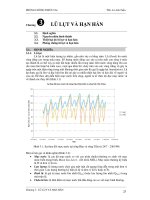Tài liệu 33 Synthetic Aperture Radar Algorithms doc
Bạn đang xem bản rút gọn của tài liệu. Xem và tải ngay bản đầy đủ của tài liệu tại đây (245.36 KB, 15 trang )
Clay Stewart. “Synthetic Aperture Radar Algorithms.”
2000 CRC Press LLC. <>.
SyntheticApertureRadar
Algorithms
ClayStewart
ScienceApplicationsInternational
Corporation
VicLarson
ScienceApplicationsInternational
Corporation
33.1Introduction
33.2ImageFormation
Side-LookingAirborneRadar(SLAR)
•
UnfocusedSynthetic
ApertureRadar
•
FocusedSyntheticApertureRadar
33.3SARImageEnhancement
33.4AutomaticObjectDetectionandClassificationinSAR
Imagery
References
FurtherReadingandOpenResearchIssues
33.1 Introduction
Asyntheticapertureradar(SAR)isaradarsensorthatprovidesazimuthresolutionsuperiortothat
achievablewithitsrealbeambysynthesizingalongapertureusingplatformmotion.Thegeometryfor
theproductionoftheSARimageisshowninFig.33.1.TheSARisusedtogenerateanelectromagnetic
mapofthesurfaceoftheearthfromanairborneorspaceborneplatform.Thiselectromagneticmap
ofthesurfacecontainsinformationthatcanbeusedtodistinguishdifferenttypesofobjectsthatmake
upthesurface.Thesensoriscalledasyntheticapertureradarbecauseasyntheticapertureisusedto
achievethenarrowbeamwidthnecessarytogetahighcross-rangeresolution.InSARimagerythe
twodimensionsarerange(perpendiculartothesensor)andcross-range(paralleltothesensor).The
rangeresolutionisachievedusingahighbandwidthpulsedwaveform.Thecross-rangeresolution
isachievedbymakinguseoftheforwardmotionoftheradarplatformtosynthesizealongaperture
givinganarrowbeamwidthandhighcross-rangeresolution.Thepulsereturnscollectedalongthis
syntheticaperturearecoherentlycombinedtocreatethehighcross-rangeresolutionimage.ASAR
sensorisadvantageouscomparedtoanopticalsensorbecauseitcanoperatedayandnightthrough
clouds,fog,andrain,aswellasatverylongranges.Atverylownominaloperatingfrequencies,less
than1GHz,theradarevenpenetratesfoliageandcanimageobjectsbelowthetreecanopy.The
resolutionofaSARgroundmapisalsonotfundamentallylimitedbytherangefromthesensorto
theground.Ifagivenresolutionisdesiredatalongerrange,thesyntheticaperturecansimplybe
madelongertoachievethedesiredcross-rangeresolution.
ASARimagemaycontain“speckle”orcoherentnoisebecauseitresultsfromcoherentprocessingof
thedata.ThisspecklenoiseisacommoncharacteristicofhighfrequencySARimageryandreducing
speckle,orbuildingalgorithmsthatminimizespeckle,isamajorpartofprocessingSARimagery
beyondtheimageformationstage.Traditionaltechniquesaveragedtheintensityofadjacentpixels,
resultinginasmootherbutlowerresolutionimage.AdvancedSARsensorscancollectmultiple
polarimetricand/orfrequencychannelswhereeachchannelcontainsuniqueinformationaboutthe
c
1999byCRCPressLLC
FIGURE 33.1: SAR imaging geometry.
surface. Recent systems have also used elevation angle diversity to produce 3-D SAR images using
interferometric techniques. In all of these techniques, some sort of averaging is employed to reduce
the speckle.
The largest consumers of SAR sensors and products are the defense and intelligence communities.
These communities use SAR to locate and target relocatable and fixed objects. Manmade objects,
especially ones with sharp corners, have very bright signals in SAR imagery, making these objects
particularly easy tolocatewith a SAR sensor. A technology similar toSAR isinverse synthetic aperture
radar (ISAR) which employs motion of the platform to image the target in cross-range. The ISAR
data can be collected from a fixed radar platform since the target motion creates the viewing angle
diversity necessary to achieve a given cross-range resolution. ISAR systems have been used to image
ships, aircraft, and ground vehicles.
Inaddition tothe defense and intelligence applications of SAR, thereareseveral commercial remote
sensing applications. Because a SAR sensor can operate day and night and in all weather, it provides
the ability to collect data at regular intervals uninterrupted by natural influences. This stable source
of ground mapping information is invaluable in tracking agriculture and other natural resources.
SAR sensors have also been used to track oil spills (oil-coated water has a different backscatter than
natural water), image underground rock formations (at some frequencies the radar will penetrate
some soils), track ice conditions in the Arctic, and collect digital terrain elevation data.
Radar is an abbreviation for RAdio Detection And Ranging. Radar was developed in the 1930s and
1940s to detect and track ships and aircraft. These surveillance and tracking radars were designed
so that a target was contained in a single resolution cell. The size of the resolution cell was a critical
design parameter. Smaller resolution cells allowed one to determine the location of a target more
accurately and increased the target-to-clutter ratio, improving the ability to detect a target. In the
c
1999 by CRC Press LLC
1950s it was observed that one could map the ground (an extended target that takes up more than
one resolution cell) by mounting the radar on the side of an aircraft and building a surface map from
the radar returns. High range resolution was achieved by using a short pulse or high bandwidth
waveform. The cross-range resolution was limited by the size of the antenna, with the cross-range
resolution roughly proportional to R/L
a
where R is the range from the sensor to the ground and
L
a
is the length of the antenna. The physical length of the antenna was constrained, limiting the
resolution. In 1951, Carl Wiley of the Goodyear Aircraft Corporation noted that the reflections from
two fixed targets in the antenna beam, but at different angular positions relative to the velocity vector
of the platform, could be resolved by frequency analysis of the along track (or cross-range) signal
spectrum. Wiley simply observed that each target had different Doppler characteristics because of its
relative position to the radar platform and that one could exploit the Doppler to separate the targets.
The Doppler effect is, of course, the change in frequency of a signal transmitted or received from a
moving platform discovered by Christian J. Doppler in 1853:
f
d
= ν/λ
where f
d
is the Doppler shift, ν is the radial velocity between the radar and target, and λ is the
radar wavelength. While the Doppler effect had been used in radar processing before the 1950s to
separate moving targets from stationary ground clutter, Wiley’s contribution was to discover that
with a side looking airborne radar (SLAR), Doppler could be used to improve the cross-range spatial
resolution of the radar. Other early work on SAR was done independently of Wiley at the University
of Illinois and the University of Michigan during the 1950s. The first demonstration of SAR mapping
was done in 1953 by the University of Illinois by performing frequency analysis of data collected by
a radar operating at a 3-cm wavelength from a C-46 aircraft. Much work has been accomplished
perfecting SAR hardware and processing algorithms since the first demonstration. For a much
more detailed description of the history of SAR including the development of focused SAR, phase
compensation techniques, calibration techniques, and autofocus, see the recent book by Curlander
and McDonough [1].
Before offering a brief description of some processing approaches for forming, enhancing, and
interpreting SAR imagery, we give two examples of existing SAR systems and their applications. The
firstsystemistheShuttleImagingRadar(SIR)developedbytheNASA JetPropulsionLaboratory (JPL)
and flown on several space shuttle missions. This system was designed for non-military collection
of geographic data. The second example is the Advanced Detection Technology Sensor (ADTS)
built by the Loral Corporation for the MIT Lincoln Laboratory. The ADTS sensor was designed to
demonstrate the capability of a SAR to detect and classify military targets. Table 33.1 contains the
basic parameters for the ADTS and SIR SAR systems along with details on several other SAR systems.
Figure 33.2 shows an example image formed from data collectedby the SIR SAR. The JPL engineers
describe this image as follows:
ThisisaradarimageofMountRainierinWashingtonstate... Thisimagewasacquired
by the Spaceborne Imaging Radar-C and X-band Synthetic Aperture Radar (SIR-C/X-
SAR) aboard the space shuttle Endeavor on its 20th orbit on October 1, 1994. The area
shown in the image is approximately 59 kilometers by 60 kilometers (36.5 miles by 37
miles). North is toward the top left of the image, which was composed by assigning red
and green colors to the L-band, horizontally transmitted and vertically received, and
the L-band, horizontally transmitted and vertically received. Blue indicates the C-band,
horizontally transmitted and vertically received. In addition tohighlighting topographic
slopes facing the space shuttle, SIR-C records rugged areas as brighter and smooth areas
as darker. The scene was illuminated by the shuttle’s radar from the northwest so that
northwest-facing slopes are brighter and southeast-facing slopes are dark. Forested
regions are pale green in color; clear cuts and bare ground are bluish or purple; ice is
c
1999 by CRC Press LLC
TABLE 33.1 Example SAR Systems
Resolution Swath
Platform Bands polarization (m) width Interferometry
JPL AIRSAR C, L, P–Full 4 10–18 km Cross track L,C
Along track L,C
SIR-C/X-SAR C, L–Full,X-VV 30
×
30 15–90 Multi-pass
ERIM IFSARE X–HH 2.5
×
0.8 10 km Cross track
ERIM DCS X–Full
<
1 1 km Cross track
MIT LL ADTS Ka (33 GHz)–Full 0.33 400 m Multi-pass
NORDEN G11 Ku–VV 1,3 5 km 3 Along track
3 Cross track
Phase centers
SRI UWB 100–300 MHz, 1
×
1 400–600 m None
FOLPEN 2 200–400 MHz,
300–500 MHz,
HH
LORAL UHF 500–800 MHz, 0.6
×
0.6 280 m None
MSAR Full
NAWC P-3 C, L, X–Full 1.5
×
0.7 5 km Along track X,C
NAWC P-3 600 MHz–Full 0.33
×
0.66 930 km None
UWB Upgrade tunable over 200–
900 MHz
Tier II+ UAV X 1 and 0.3 10 km None
SAR
dark green and white. The round cone at the center of the image is the 14,435-foot
(4,399-meter) active volcano, Mount Rainier. On the lower slopes is a zone of rock
ridges and rubble (purple to reddish) above coniferous forests (in yellow/green). The
western boundary of MountRainier National Park is seen as a transition from protected,
old-growth forest to heavily logged private land, a mosaic of recent clear cuts (bright
purple/blue) and partially regrown timber plantations (pale blue).
Figure 33.3 is an example image collected by the ADTS system. The ADTS system operates at a
nominal frequency of 33 GHz and collects fully polarimetric, 1-ft resolution data. This image was
formed using the polarimetric whitening filter (PWF) combination of three polarimetric channels
to reduce the speckle noise. The output of the PWF is an estimate of radar backscatter intensity. The
image displayed in Fig. 33.3 is based on a false color map which maps low intensity to black followed
by green, yellow, and finally white. The color map simply gives the non-color radar sensor output
false colors that make the low intensity shadows look black, the grass look green, the trees look yellow,
and bright objects look white. This sample image was collected near Stockbridge, New York, and is
of a house with an above ground swimming pool and several junked cars in the backyard. The radar
is at the top of the image looking down at a 20
◦
depression angle. The scene contains large areas of
grass or crops and some foliage. Note the bright returns from the manmade objects, including the
circular above-ground swimming pool, and strong corner reflector scattering from some of the cars
in the backyard. Also note the relatively strong return from the foliage canopy. At this frequency the
radar does not penetrate the foliage canopy. Note the shadows behind the trees where there is no
radar illumination.
In this chapter on SAR algorithms, we give a brief introduction to the image formation process
in Section 33.2. We review a few simple algorithms for reducing speckle noise in SAR imagery
and automatic detection of manmade objects in Section 33.3. We review a few simple automatic
object classification algorithms for SAR imagery in Section 33.4. This brief introduction to SAR only
contains a few example algorithms. In the Section “Further Reading”, we recommend some starting
c
1999 by CRC Press LLC
FIGURE 33.2: SAR image of Mt. Rainier in Washington State taken from shuttle imaging radar.
points for further reading on SAR algorithms, and discuss several open issues under current research
in the SAR community.
33.2 Image Formation
In this section, we discuss some basic principles of SAR image formation. For more detailed infor-
mation about SAR image formation, the reader is directed to the references given at the end of this
chapter. One fundamental scenario under which SAR data is collected is shown in Fig. 33.1.An
aircraft flies in a straight path at a constant velocity and collects radar data at a boresight of 90
◦
.In
practice it is impossible for an aircraft to fly in a perfectly straight line at a constant velocity (at least
within a wavelength), so motion (phase) compensation of the received radar signal is needed to ac-
count for aircraft perturbations. The radar on the aircraft transmits a short pulsed waveform or uses
frequency modulation to achieve high range resolution imaging of the surface. The pulses collected
from several positions along the trajectory ofthe aircraft are coherently combined to synthesize a long
synthetic aperture in order to achieve a high cross-range resolution on the surface. In this section,
we first discuss SLAR where only range processing is performed. Next, we discuss unfocused SAR
where both range and cross-range processing are executed. Finally, we discuss focused SAR where
“focusing” is performed in addition to range and cross-range processing to achieve the highest reso-
lution and best image quality. At the end of this section we briefly mention several other important
c
1999 by CRC Press LLC









